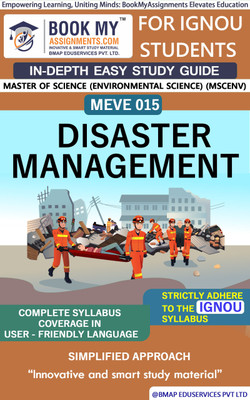IGNOU MEVE 15 Disaster Management In Depth Guide For Ignou Student(Paperback, BMA Publication)
Quick Overview
Product Price Comparison
IGNOU's MEVE 15 (Disaster Management) course involves understanding the principles, frameworks, and strategies for managing disasters and building resilience in communities and ecosystems. Here's an in-depth guide to help you excel in your studies:Review the Syllabus: Start by thoroughly reviewing the syllabus provided by IGNOU for the MEVE 15 course. This will outline the topics you need to cover and the structure of the course.Study Material: Utilize the study materials provided by IGNOU for the course. These materials typically cover fundamental concepts in disaster management, including disaster risk reduction, preparedness, response, recovery, and resilience building.Textbooks and References: Supplement your study materials with textbooks and reference books on disaster management. Some recommended textbooks include "Introduction to Emergency Management" by George D. Haddow, Jane A. Bullock, and Damon P. Coppola, "Disaster Management: International Lessons in Risk Reduction, Response and Recovery" edited by David Alexander, and "Disaster Resilience: An Integrated Approach" by Douglas Paton and David Johnston.Understanding Disasters: Disasters are events that cause significant disruption, damage, or destruction to human lives, property, and the environment. Study the different types of disasters, including natural disasters (e.g., earthquakes, floods, hurricanes, wildfires) and human-made disasters (e.g., industrial accidents, terrorist attacks, pandemics).Disaster Risk Assessment: Learn about methods and techniques for assessing disaster risks, vulnerabilities, and impacts. Explore hazard mapping, vulnerability assessments, risk analysis, and scenario-based modeling to identify high-risk areas and prioritize risk reduction measures.Disaster Risk Reduction (DRR): Understand the principles and approaches of disaster risk reduction for preventing or mitigating the impacts of disasters. Study strategies such as land-use planning, building codes and standards, early warning systems, ecosystem-based approaches, and community-based preparedness.Disaster Preparedness and Response: Explore the components of disaster preparedness and response, including emergency planning, evacuation procedures, search and rescue operations, medical care, and humanitarian assistance. Learn about incident command systems, coordination mechanisms, and multi-agency collaboration in disaster response.Disaster Recovery and Rehabilitation: Study the process of disaster recovery and rehabilitation for restoring affected communities, infrastructure, and ecosystems. Learn about post-disaster needs assessments, reconstruction efforts, livelihood restoration, psychosocial support, and long-term recovery planning.


